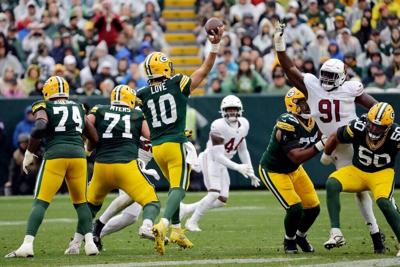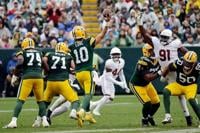GREEN BAY — It wasn’t that long ago that Adam Stenavich was trying to make it in the NFL as a player — even if there are probably more than a few guys on the Green Bay Packers’ roster who are unaware of it.
“[It was] many moons ago,” the Packers offensive coordinator emphasized during a break in the team’s offseason program.
OK, maybe it was. And that speaks to just how long the Packers have been taking college left tackles and moving them to alternative positions on the offensive line.
“We’ve had a ton of luck throughout my years here of taking guys who played left tackle and moving them inside,” said Packers general manager Brian Gutekunst, who spent 20 years in the team’s personnel department as a scout before becoming GM in 2018.
“It wasn’t like we specifically said, ‘Hey, we want to take a left tackle.’ I think we wanted to take a certain kind of athlete that usually does play left tackle. Those guys usually have the kind of versatility we’re looking for.
“We’ve certainly had a lot of success there. There’s no doubt about it.”
That they have, and it all started two decades ago with general manager Ted Thompson — a philosophy that included converting the now 42-year-old Stenavich, who’s gone from a roster hopeful who’d signed with his home state Packers as an undrafted free agent, to coaching the team’s offensive line for three seasons, to now entering his fourth year as the offensive coordinator.
Stenavich had started 39 games at left tackle at the University of Michigan, but once he arrived for training camp, his days at the premier position on the offensive line were over.
“I went to guard my first camp,” Stenavich remembered.
He wasn’t the only one.
In Thompson’s first draft in 2005 — the one in which he famously selected California quarterback Aaron Rodgers with his first pick as GM, despite having future Pro Football Hall of Famer Brett Favre on his roster — he selected a little-known North Carolina A&T lineman in the fifth round: Junius Coston, who’d played three positions, including left tackle, in college.
A year later, Thompson picked three more linemen: Boise State’s Daryn Colledge in the second round, Louisville’s Jason Spitz in the third round and Nevada’s Tony Moll in the fifth round — with all three rookies starting at least 10 games that season. While Spitz never played left tackle, Colledge was a 52-game starter at left tackle for the Broncos and Moll bulked up 50 pounds to move from tight end to left tackle his final season for the Wolf Pack. Thompson also signed Stenavich as an undrafted free agent that year.
In the years that followed, Thompson’s best offensive lineman picks were almost always college tackles: Josh Sitton (fourth round, 2008); T.J. Lang (fourth round, 2009); Marshall Newhouse (fifth round, 2010); Bryan Bulaga (first round, 2010); David Bakhtiari (fourth round, 2013); JC Tretter (fourth round, 2013); and Corey Linsley (fifth round, 2014). Of that group, Linsley was the only one who wasn’t a college tackle, and of those, only Sitton wasn’t primarily a left tackle, spending most of his Central Florida career at right tackle.
And in the NFL, only Bakhtiari wound up being a full-time left tackle — and even he was on the verge of moving to left guard during his rookie training camp in 2013 until Bulaga, slated to switch from right tackle to left tackle that year, tore the ACL in his knee during the Family Night Scrimmage, forcing Bakhtiari to start there as a rookie.
When Gutekunst took over as GM, he didn’t necessarily follow that blueprint early on in his tenure, although he didn’t take many offensive linemen of any kind initially. His lone offensive line pick in his first year was Washington State right tackle Cole Madison, who never played a down in Green Bay due to injuries.
And the only lineman Gutekunst took in 2019 was Mississippi State center Elgton Jenkins, who started 26 games in college at center, five at left tackle, two at left guard and one at right tackle — and has turned out to be one of the most versatile linemen in Packers history, shifting to center for the 2025 season.
Since then, though, Gutekunst has leaned heavily into the Thompson approach. Of the 14 offensive linemen Gutekunst has taken over the past six drafts, eight of them — Jon Runyan in 2020, Sean Rhyan, Zach Tom and Rasheed Walker in 2022, Jordan Morgan and Travis Glover in 2024 and Anthony Belton and John Williams last month — were primarily college left tackles.
“I just think typically most teams are going to put their best offensive lineman at the left tackle position, provided that they have the prerequisites to play that position,” Packers head coach Matt LaFleur explained. “Traditionally, I think our guys have done a great job of really targeting those types of players. Typically, your best [lineman] is in that spot, so a lot of those guys get drafted in the National Football League — and then it's on us as a staff to try to develop those guys if we see the need and/or the fit to move ‘em inside.”
Ryan (31 left tackle starts at UCLA), Tom (23 at Wake Forest), Walker (32 at Penn State) and Morgan (37 at Arizona) all came to Green Bay as longtime left tackles in college, and yet Walker is the only one to have played the position extensively with the Packers.
Rhyan hasn’t played a snap a left tackle and has played almost exclusively at guard; of Tom’s 39 NFL starts, 34 have been right tackle compared to four at left tackle; and Morgan’s only start as a rookie first-round pick last season came at left guard, although the Packers have set up a Walker-versus-Morgan training-camp competition for the starting left tackle job this summer.
“For me, there’s a skillset that they have to have to be able to play both tackle and guard,” Gutekunst said of his philosophy. “That’s been a big emphasis for us. We like to have guys that can play both. You’re either going to be a tackle/guard swing guy, a guard/center swing guy or a tackle/center swing guy. You’ve got to be able to play multiple spots.
“When you know you’re only going to carry eight on game day, maybe nine on your active roster and 10, 11 with the practice squad, those guys are going to have to play multiple spots. The big thing for me with the big guys, with what Matt likes to do on offense, is whether they’re inside or out, do they have enough quickness? And all these guys that we’ve taken, we feel pretty good about that.”
While Lang and Sitton both did have that quickness, going on to earn six Pro Bowl selections between them at guard, Stenavich by his own admission did not. While he spent the 2006 season on the Packers’ practice squad and went to camp with them in 2007, he never saw regular-season action during his time as a player in Green Bay.
But that experience undeniably has benefitted him when it comes to projecting who should play where up front.
“I think that’s what helped me in coaching, when you learn everything and have to know it all,” Stenavich said. “The further you go inside [on the offensive line], the faster things happen. So you just have to change up how you play.
“Tackles are used to, you get a little time to see what’s going on and then you can react. When you move inside, now everything is obviously happening quicker. You’ve got to be stouter with your sets, quicker with your hands, all that stuff.
“There is a transition for sure when guys move inside. Obviously, guys that are more athletic — like Jordan, compared to myself back in the day — it’s probably a little bit easier, you know what I mean? It takes a little bit of getting used to, though. That’s for sure.”
COPYRIGHT 2025 BY CHANNEL 3000. ALL RIGHTS RESERVED. THIS MATERIAL MAY NOT BE PUBLISHED, BROADCAST, REWRITTEN OR REDISTRIBUTED.




